2010ICSI+稳定性冠心病诊治指南
稳定性冠心病诊疗指南
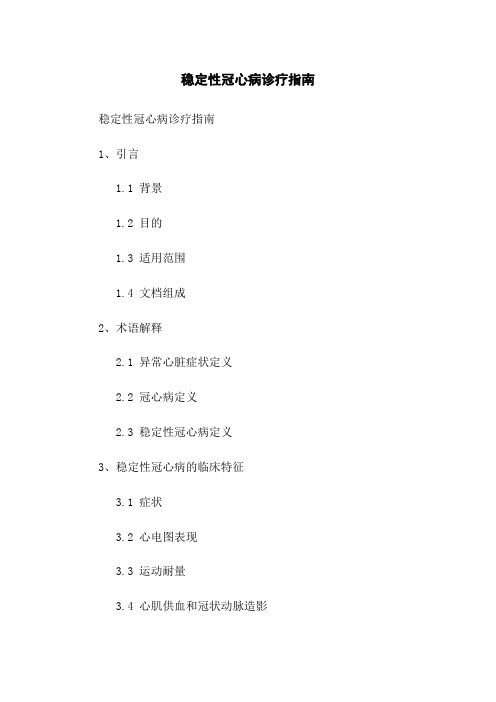
稳定性冠心病诊疗指南稳定性冠心病诊疗指南1、引言1.1 背景1.2 目的1.3 适用范围1.4 文档组成2、术语解释2.1 异常心脏症状定义2.2 冠心病定义2.3 稳定性冠心病定义3、稳定性冠心病的临床特征3.1 症状3.2 心电图表现3.3 运动耐量3.4 心肌供血和冠状动脉造影3.5 其他实验室检查4、稳定性冠心病的危险因素评估4.1 非可逆危险因素4.2 可逆危险因素4.3 评估方法5、稳定性冠心病的治疗目标5.1 减轻症状5.2 改善生活质量5.3 预防心肌梗死、心力衰竭和猝死 5.4 控制冠心病进展5.5 并发症的预防6、稳定性冠心病的非药物治疗6.1 生活方式干预6.2 心理支持6.3 遗传咨询6.4 环境干预6.5 康复治疗7、稳定性冠心病的药物治疗 7.1 抗血小板治疗7.2 扩血管药物7.3 抗心绞痛药物7.4 抗高血压药物7.5 抗高血脂药物7.6 其他药物治疗8、心导管治疗8.1 食管超声心动图8.2 经皮冠状动脉介入治疗 8.3 心脏电生理检查8.4 心脏手术治疗9、并发症处理9.1 冠心病相关的并发症 9.2 治疗并发症的一般措施 9.3 特殊并发症处理附件:附件1:稳定性冠心病诊断标准附件2:稳定性冠心病药物治疗方案附件3:稳定性冠心病介入治疗示意图附件4:相关实验室检查指南法律名词及注释:1、冠心病:一种由于冠状动脉供血不足引起的心肌缺血症状的心血管疾病。
2、稳定性冠心病:指冠心病患者在相对稳定状态下出现心绞痛或心肌缺血的症状。
3、心肌梗死:心肌血液供应中断导致的心肌组织坏死。
4、心力衰竭:心脏无法有效泵血,导致血液循环障碍和器官功能衰竭。
5、猝死:突然发生的死亡,可能由心脏停止跳动引起。
6、生活质量:个人生活中与健康状况有关的体验和满意度。
7、遗传咨询:通过遗传咨询师对遗传疾病患者进行家族调查和遗传风险评估。
8、环境干预:改变生活环境以减少某些心脏病危险因素的措施。
医学信息学论文:冠状动脉粥样硬化性心脏病诊断标准2010

;
肥 厚 梗 阻性 心 肌 病
;
;
o
d) e)
不 稳定 型心 绞 痛
;
静 息 心 电图 ST段 下 移 >1mm; 完 全 性 左束 支 传 导 阻滞 (LBBB); 预激 综 合 征
;
D
g) h)
心室 起 搏 心 律及 正 在服用 地 高辛 的患 者 。
4.1.3.4 超 声 心 动 图裣 查
,症 状 可 在
d)
e)
诱发症状的活动或舌下食
2mh~5min
也 有 一 些 患 者表 现为不 典 型
或 窒 息感 。
、 部 或 上 腹 部 ,性 质 为烧 灼 感 咽
4.1.2.2
体征 :稳 定 型心绞痛患者常无 明显特异性体征 ,有 时伴 随心率加快和血压增高 。
4.1.3 辅 助检查
4.1.3.1 血 液 生化检 查
CABG:冠 状 动 脉旁 路 移植 术 (cor。 nary
artery bypass graft)
1
Ws 319-ˉ 2010
CCB:钙 通 道 阻断剂 (ca1cium channel blockeo
C(MB:肌 酸激 酶 同功酶 (MB厶 oenzymc of creat“ e hnase) CTA:CT血 管造影 (computcd tomography angiographD
5.l。 2.3、 5.2、
6.1.1、 6.1.2、 6.2、 7.1、 7.2为 强制 性 条 款 ,其 余 为 推荐 性条 款 。
冠 状 动 脉 粥 样 硬 化 性 心脏 病 可 分 为 以下 类 型 :稳 定 型心 绞 痛 、 ST段 抬 高 急性 冠 状 动 脉 综 合 征 、 非 sT段 抬 高 急性 心肌梗 死 、 症 状性 心 肌 缺 血 和 心 脏 性 猝 死 。本 标 准按 照 冠 状 动 脉 粥 样 硬 化 性 心脏 病 无 的类 型分 章 规 定 。 本 标 准 的附录
2024中国稳定性冠心病诊断与治疗指南
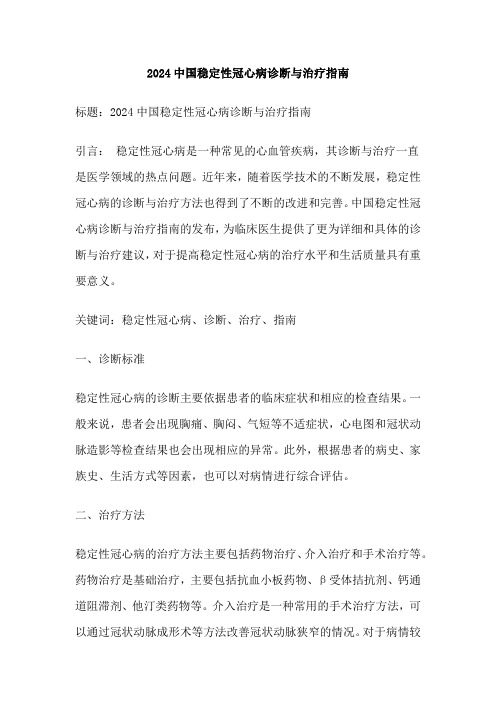
2024中国稳定性冠心病诊断与治疗指南标题:2024中国稳定性冠心病诊断与治疗指南引言:稳定性冠心病是一种常见的心血管疾病,其诊断与治疗一直是医学领域的热点问题。
近年来,随着医学技术的不断发展,稳定性冠心病的诊断与治疗方法也得到了不断的改进和完善。
中国稳定性冠心病诊断与治疗指南的发布,为临床医生提供了更为详细和具体的诊断与治疗建议,对于提高稳定性冠心病的治疗水平和生活质量具有重要意义。
关键词:稳定性冠心病、诊断、治疗、指南一、诊断标准稳定性冠心病的诊断主要依据患者的临床症状和相应的检查结果。
一般来说,患者会出现胸痛、胸闷、气短等不适症状,心电图和冠状动脉造影等检查结果也会出现相应的异常。
此外,根据患者的病史、家族史、生活方式等因素,也可以对病情进行综合评估。
二、治疗方法稳定性冠心病的治疗方法主要包括药物治疗、介入治疗和手术治疗等。
药物治疗是基础治疗,主要包括抗血小板药物、β受体拮抗剂、钙通道阻滞剂、他汀类药物等。
介入治疗是一种常用的手术治疗方法,可以通过冠状动脉成形术等方法改善冠状动脉狭窄的情况。
对于病情较为严重的患者,手术治疗也是一种有效的治疗方法。
三、预防措施预防措施是提高稳定性冠心病生活质量的重要手段。
患者应该注意控制血压、血糖和血脂等危险因素,保持健康的生活方式,如低盐、低脂、适量运动、戒烟限酒等。
此外,定期进行体检和相应的检查也是预防措施的重要一环。
四、管理建议对于稳定性冠心病患者,医院和医生应该提供全面的管理和治疗方案,包括药物治疗、生活方式干预和心理支持等。
同时,医院还应该建立完善的随访制度,及时了解患者的病情变化和治疗效果,以便及时调整治疗方案。
五、案例分析通过分析一些典型案例,我们可以更好地理解稳定性冠心病的诊断与治疗方法。
例如,一位55岁的男性患者,因胸痛、胸闷等症状就诊,心电图和冠状动脉造影检查结果提示冠状动脉狭窄。
经过药物治疗和生活方式干预后,患者的症状得到明显缓解,治疗效果良好。
稳定性冠心病诊断与治疗指南(二)
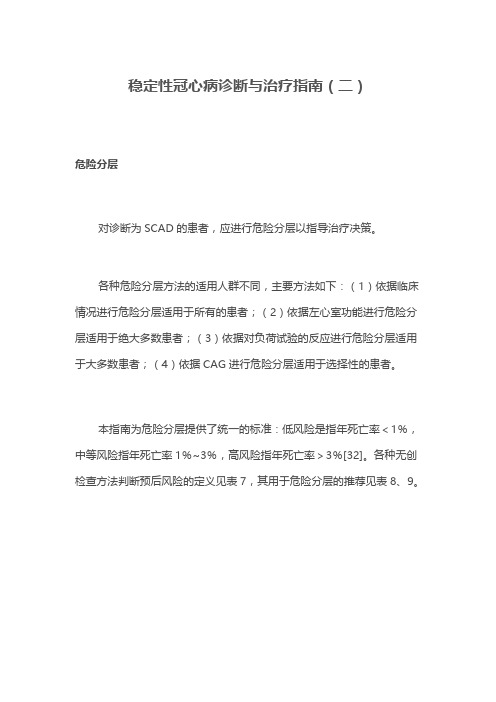
稳定性冠心病诊断与治疗指南(二)危险分层对诊断为SCAD的患者,应进行危险分层以指导治疗决策。
各种危险分层方法的适用人群不同,主要方法如下:(1)依据临床情况进行危险分层适用于所有的患者;(2)依据左心室功能进行危险分层适用于绝大多数患者;(3)依据对负荷试验的反应进行危险分层适用于大多数患者;(4)依据CAG进行危险分层适用于选择性的患者。
本指南为危险分层提供了统一的标准:低风险是指年死亡率<1%,中等风险指年死亡率1%~3%,高风险指年死亡率>3%[32]。
各种无创检查方法判断预后风险的定义见表7,其用于危险分层的推荐见表8、9。
长期动态评估有冠心病病史的SCAD患者,其病情可能长期稳定,也可能出现变化,如病程中发生不稳定性心绞痛、心肌梗死、心力衰竭等。
在病程的某个阶段,部分患者可能需要进行血运重建治疗。
对首次评估为低危,但其危险程度可能发生了变化的患者,建议定期再次评估,以便准确掌握其病情变化(表10)。
治疗建议根据临床症状学(特别是心绞痛严重程度)、PTP及必要的无创性检查方法对预后的评价来进行诊疗决策(图1)。
PTP为验前概率,CAG为冠状动脉造影,FFR为血流储备分数图1 确诊稳定性冠心病的胸痛患者基于预后风险的诊疗策略一、药物治疗SCAD患者接受药物治疗有两个目的,即缓解症状及预防心血管事件。
(一)缓解症状、改善缺血的药物目前缓解症状及改善缺血的药物主要包括三类:β受体阻滞剂、硝酸酯类药物和钙通道阻滞剂(calcium channel blocker, CCB)。
缓解症状与改善缺血的药物应与预防心肌梗死和死亡的药物联合使用,其中β受体阻滞剂同时兼有两方面的作用。
1.β受体阻滞剂:只要无禁忌证,β受体阻滞剂应作为SCAD患者的初始治疗药物。
β受体阻滞剂通过抑制心脏β肾上腺素能受体,减慢心率、减弱心肌收缩力、降低血压以减少心肌耗氧量,还可通过延长舒张期以增加缺血心肌灌注,因而可以减少心绞痛发作和提高运动耐量。
欧洲心脏病学会的稳定性冠心病指南解读!
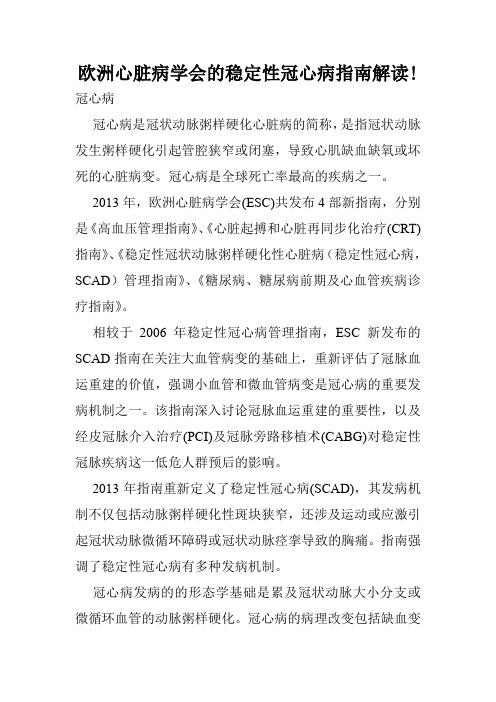
欧洲心脏病学会的稳定性冠心病指南解读! 冠心病冠心病是冠状动脉粥样硬化心脏病的简称,是指冠状动脉发生粥样硬化引起管腔狭窄或闭塞,导致心肌缺血缺氧或坏死的心脏病变。
冠心病是全球死亡率最高的疾病之一。
2013年,欧洲心脏病学会(ESC)共发布4部新指南,分别是《高血压管理指南》、《心脏起搏和心脏再同步化治疗(CRT)指南》、《稳定性冠状动脉粥样硬化性心脏病(稳定性冠心病,SCAD)管理指南》、《糖尿病、糖尿病前期及心血管疾病诊疗指南》。
相较于2006年稳定性冠心病管理指南,ESC新发布的SCAD指南在关注大血管病变的基础上,重新评估了冠脉血运重建的价值,强调小血管和微血管病变是冠心病的重要发病机制之一。
该指南深入讨论冠脉血运重建的重要性,以及经皮冠脉介入治疗(PCI)及冠脉旁路移植术(CABG)对稳定性冠脉疾病这一低危人群预后的影响。
2013年指南重新定义了稳定性冠心病(SCAD),其发病机制不仅包括动脉粥样硬化性斑块狭窄,还涉及运动或应激引起冠状动脉微循环障碍或冠状动脉痉挛导致的胸痛。
指南强调了稳定性冠心病有多种发病机制。
冠心病发病的的形态学基础是累及冠状动脉大小分支或微循环血管的动脉粥样硬化。
冠心病的病理改变包括缺血变性和不同程度的梗死(坏死)乃至硬化(纤维化)的分阶段演化过程,这是动脉粥样硬化独特而重要的表现之一。
最新的指南指出心肌缺血的发病机制:1固定的或动态的心外膜冠状动脉狭窄2微血管功能障碍3局灶性或弥漫性心外膜冠状动脉狭窄4上述机制可能会有重叠,并随着时间的迁移可能会发生改变急性心肌缺血的最主要原因是动脉粥样硬化斑块破裂、导致血小板黏附、聚集、血栓形成。
容易发生破裂的易损斑块往往脂质核心大、纤维帽薄,并且局部有较多炎性细胞浸润。
通过减小脂核、增厚纤维帽、减轻炎症等措施可以稳定易损斑块,防止破裂。
麝香保心丸对血管的保护作用是多方面的,从早期的血管保护作用,到抑制炎症反应和稳定动脉粥样硬化斑块,都贯穿于疾病发生的全过程[1]。
稳定性冠心病基层诊疗指南

04
性发病率略高于女性。
冠心病的分类
稳定性冠心病:指冠状动脉粥样 硬化导致的心肌缺血,但病情相 对稳定,无急性心肌梗死或心力
衰竭等严重并发症。
急性心肌梗死:指冠状动脉急性 闭塞,导致心肌缺血、缺氧,进
而引起心肌坏死。
不稳定性冠心病:指冠状动脉粥 样硬化导致的心肌缺血,病情不 稳定,易发生急性心肌梗死或心
力衰竭等严重并发症。
心力衰竭:指由于各种原因导致 的心脏功能不全,无法满足全身 组织器官的血液供应,导致呼吸
困难、水肿等症状。
冠心病的危害
01
心肌缺血:导 致胸痛、心悸、 呼吸困难等症
状
02
心力衰竭:心 脏功能下降, 影响生活质量
和预期寿命
03
心律失常:可 能导致猝死等
严重后果
04
心肌梗死:危 及生命,需要
辅助检查
01
心电图:检查心脏电活动,判断心肌
缺血、心律失常等情况
02
超声心动图:检查心脏结构和功能,了
解心脏瓣膜、心肌、心包等病变情况
03
心肌酶学检查:检测心肌损伤标志物,
判断心肌缺血、梗死等情况
04
冠状动脉造影:检查冠状动脉狭窄、阻
塞等情况,为介入治疗提供依据
诊断标准
病史:患者有胸痛、胸闷、心悸等症状 心脏超声:显示心肌肥厚、瓣膜病变等 冠脉造影:显示冠状动脉狭窄或阻塞 心电图负荷试验:显示心肌缺血或心律失常 基因检测:显示遗传性心脏病基因突变
03
控制体重:保持正常, 避免过度紧张和焦虑
02
适量运动:每周至少150分钟的 中等强度有氧运动
04
戒烟限酒:戒烟,限制饮酒, 避免二手烟
06
2010慢性稳定性冠心病管理中国共识

2010慢性稳定性冠心病管理中国共识慢性稳定性冠心病包括明确诊断的无心绞痛症状冠心病患者和稳定性心绞痛患者。
稳定性心绞痛需要满足以下标准:近60天内心绞痛发作的频率、持续时间、诱因或缓解方式没有变化;无近期心肌损伤的证据。
明确诊断的冠心病指有明确的心肌梗死病史、经皮冠状动脉介入治疗(pci)和冠状动脉旁路移植(cabg)术后患者及冠状动脉造影或无创检查证实有冠状动脉粥样硬化或有确切心肌缺血证据的患者。
有关慢性稳定性心绞痛的诊断和治疗的内容,请参见中国《慢性稳定性心绞痛诊断与治疗指南》[1]。
慢性稳定性冠心病的管理包括危险评估和二级预防的内容,二级预防的首要目标是预防心肌梗死和死亡,从而延长寿命;第二个目标是减轻心绞痛症状,减少缺血发生,从而改善生活质量。
冠心病的二级预防是冠心病治疗的基础。
对于所有的稳定性冠心病患者,应建立合理的慢性病管理系统进行管理,这要求各地卫生系统、保健机构、医院和完整的保健实施系统通力合作;通过电话、网络、门诊等多个途径,加强与患者的沟通,建立交互的网络管理平台,纳入所有管辖患者。
管理的内容包括冠心病康复的各个方面:定期评估和控制血压、血脂、血糖等危险因素、改善生活方式(饮食教育、运动等生活方式调节及精神神经因素调节等)、二级预防药物治疗、判断何时需要进行pci和cabg等。
通过这样的管理可以显著改善患者的预后,降低再次住院率,控制或延缓冠心病进展,减少冠心病并发症,降低病残率和病死率,控制心肌缺血/心绞痛症状,提高患者生活质量。
本共识将就慢性稳定性冠心病管理实践中常见的问题,如生活方式的改善、危险因素的控制、运动康复、心肌缺血/心绞痛症状控制及精神心理康复等方面的内容作重点介绍。
1 稳定性冠心病的危险评估稳定性冠心病的危险评估应根据临床评估、左心室功能、负荷试验及冠状动脉造影检查结果综合判断。
1.1 临床评估病史、症状、体格检查、心电图及实验室检查可为预后提供重要信息;心绞痛发作的次数和诱发心绞痛发作的活动量与冠状动脉病变程度相关,是主要的预后因子。
(完整版)(完整版)稳定型心绞痛诊治指南

稳定型心绞痛诊治指南作者:欧洲心脏病学会今年欧洲心脏病学会(ESC)发布了新一版稳定型心绞痛的治疗指南,旨在帮助医生面对具体患者时选择最佳的治疗方法,同时考虑到了治疗方法对预后的影响以及特定诊治手段的危险/效益比。
该指南不但对欧洲国家稳定型心绞痛的治疗具有指导作用,而且对欧洲以外的国家和地区,包括我国的心绞痛临床实践都有非常重要的借鉴意义。
本文仅就其主要内容做一简介,以飨读者。
一、定义与病理生理学典型稳定型心绞痛的临床表现为胸部、下颌部、肩背部或上臂部的不适感,常因劳力或情绪压力而诱发,休息或含服硝酸甘油后可缓解。
最常见病因是粥样硬化所致冠状动脉管腔狭窄。
稳定型心绞痛的发生阈值在每天甚至同一天都有所不同,症状的变异性取决于关键狭窄部位的血管收缩程度(动态狭窄)和/或远端血管状况。
稳定型心绞痛患者有发生急性冠脉综合征的危险,如不稳定型心绞痛、非ST段抬高性心肌梗死或ST段抬高性心肌梗死。
二、流行病学心绞痛的诊断主要根据病史,因此具有一定的主观性,故而难以评价不同研究中患病率及发病率的差异。
一项欧洲研究发现,45~54岁女性的心绞痛患病率为0.1%~1%,而65~74岁女性的患病率则猛增至10%~15%;同样年龄组的男性患病率分别为2%~5%和10%~20%。
据此估计,大多数欧洲国家每百万人中约有2~4万心绞痛患者。
在40岁以上西方人群中,无并发症的心绞痛年发病率约为0.5%,但存在地区差异。
疾病进展和急性事件的发生并不一定与冠脉造影所显示的病变狭窄程度相关。
三、诊断与临床评估1. 诊断所有稳定型心绞痛疑似病例都需要接受迅速、恰当的心脏方面的检查,以得到正确诊断和预后评估。
医生应首先进行无创性检查,包括运动心电图、负荷超声心动图或心肌灌注扫描。
这些检查可以评价轻、中度症状患者的病情,并有助于危险分层。
进行运动试验评价时应考虑到受试者的血流动力学反应性、所达到的运动负荷、临床症状特点及心电图ST段的变化。
稳定性冠心病基层合理用药指南(2021全文版)
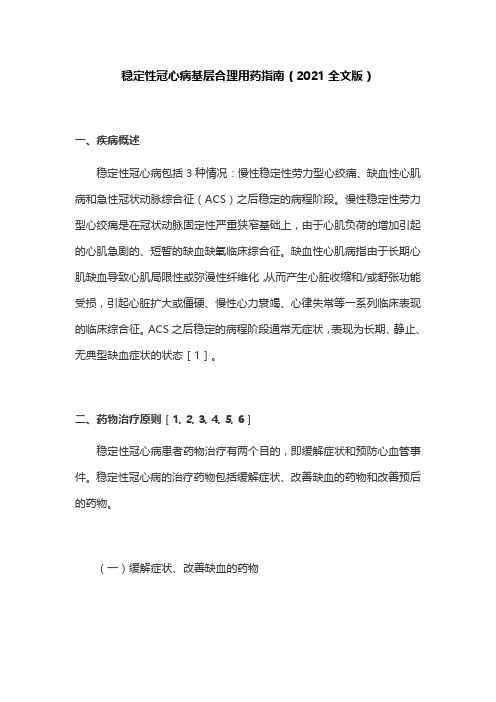
稳定性冠心病基层合理用药指南(2021全文版)一、疾病概述稳定性冠心病包括3种情况:慢性稳定性劳力型心绞痛、缺血性心肌病和急性冠状动脉综合征(ACS)之后稳定的病程阶段。
慢性稳定性劳力型心绞痛是在冠状动脉固定性严重狭窄基础上,由于心肌负荷的增加引起的心肌急剧的、短暂的缺血缺氧临床综合征。
缺血性心肌病指由于长期心肌缺血导致心肌局限性或弥漫性纤维化,从而产生心脏收缩和/或舒张功能受损,引起心脏扩大或僵硬、慢性心力衰竭、心律失常等一系列临床表现的临床综合征。
ACS之后稳定的病程阶段通常无症状,表现为长期、静止、无典型缺血症状的状态[1]。
二、药物治疗原则[1, 2, 3, 4, 5, 6]稳定性冠心病患者药物治疗有两个目的,即缓解症状和预防心血管事件。
稳定性冠心病的治疗药物包括缓解症状、改善缺血的药物和改善预后的药物。
(一)缓解症状、改善缺血的药物目前缓解症状、改善缺血的药物主要包括3类:β受体阻滞剂、硝酸酯类药物和钙通道阻滞剂。
缓解症状与改善缺血的药物应与预防心肌梗死和死亡的药物联合使用,其中β受体阻滞剂同时兼有两方面的作用。
(二)改善预后的药物此类药物可改善稳定性冠心病患者的预后,预防心肌梗死、死亡等不良心血管事件的发生。
主要包括抗血小板药物、调脂药物、β受体阻滞剂和血管紧张素转换酶抑制剂(ACEI)或血管紧张素Ⅱ受体拮抗剂(ARB)。
稳定性冠心病治疗药物的用药指征和推荐药物见表1[1, 2, 3, 4, 5, 6]。
三、治疗药物[1, 2, 3, 4, 5, 6](一)硝酸甘油1. 药品分类:硝酸酯类。
2. 用药目的:用于冠心病心绞痛的治疗及预防。
3. 禁忌证:禁用于心肌梗死早期(有严重低血压及心动过速时);严重贫血;青光眼;颅内压增高者;对硝酸甘油过敏者。
4. 不良反应:头痛、眩晕、虚弱、心悸、心动过速、直立性低血压、口干、恶心、呕吐、虚弱、出汗、苍白、虚脱、晕厥、面红、心动过缓、心绞痛加重、药疹、剥脱性皮炎等。
2024年中国稳定性冠心病诊断与治疗指南

2024年中国稳定性冠心病诊断与治疗指南标题:2024年中国稳定性冠心病诊断与治疗指南稳定性冠心病是中国心血管疾病的一种常见类型,严重威胁着人们的健康。
为了更好地指导临床实践,中国心脏学会和心血管疾病防治协会联合发布了《2024年中国稳定性冠心病诊断与治疗指南》。
稳定性冠心病是指一种慢性、稳定性的心肌缺血,通常表现为心绞痛、胸痛、气短、乏力等症状,其主要病理生理机制是冠状动脉粥样硬化。
本指南旨在为临床医生提供详尽的稳定性冠心病诊断与治疗方法,以降低患者的发病率和死亡率。
诊断是治疗稳定性冠心病的关键步骤。
指南提出了以下诊断方法:1、症状评估:详细了解患者的病史,特别是心绞痛、胸痛等症状的特征和频率。
2、体格检查:观察患者的生命体征,特别是心率和血压。
3、实验室检查:检测患者的血液生化指标,如胆固醇、血糖等。
4、心电图:检测心脏的电活动,以发现心肌缺血或梗死。
5、影像学检查:如超声心动图、冠状动脉造影等,直接观察心脏结构和血管情况。
在治疗方面,本指南提出了以下策略:1、药物治疗:使用抗血小板药物、β受体拮抗剂、钙通道阻滞剂、降脂药物等,以缓解症状、预防心肌缺血。
2、血运重建:对于严重的冠状动脉狭窄或闭塞,可以采用经皮冠状动脉介入治疗(PCI)或冠状动脉旁路移植术(CABG)等方法,恢复心肌供血。
3、生活方式的改变:建议患者改变不良的生活习惯,如戒烟、限制饮酒、保持健康的饮食和体重,同时进行适当的运动。
此外,本指南还强调了预防措施的重要性,包括一级预防和二级预防。
一级预防是指通过控制危险因素,如高血压、高血脂、糖尿病等,来预防冠心病的发生。
二级预防则是通过早期诊断和治疗,来延缓或防止病情的恶化。
总的来说,《2024年中国稳定性冠心病诊断与治疗指南》为临床医生提供了全面、科学的诊断和治疗方法,有助于提高稳定性冠心病的治疗效果,降低患者的发病率和死亡率。
同时,本指南也强调了预防措施的重要性,通过控制危险因素和早期干预,可以有效地预防和延缓冠心病的发生。
稳定性冠心病诊断和治疗指南解读
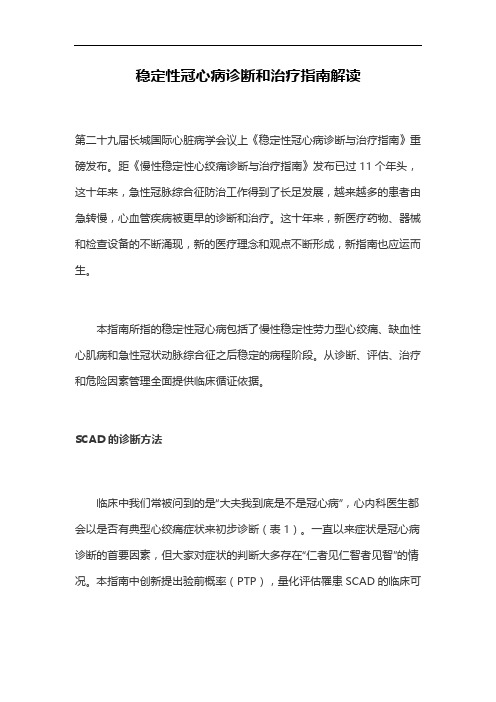
稳定性冠心病诊断和治疗指南解读第二十九届长城国际心脏病学会议上《稳定性冠心病诊断与治疗指南》重磅发布。
距《慢性稳定性心绞痛诊断与治疗指南》发布已过11个年头,这十年来,急性冠脉综合征防治工作得到了长足发展,越来越多的患者由急转慢,心血管疾病被更早的诊断和治疗。
这十年来,新医疗药物、器械和检查设备的不断涌现,新的医疗理念和观点不断形成,新指南也应运而生。
本指南所指的稳定性冠心病包括了慢性稳定性劳力型心绞痛、缺血性心肌病和急性冠状动脉综合征之后稳定的病程阶段。
从诊断、评估、治疗和危险因素管理全面提供临床循证依据。
SCAD的诊断方法临床中我们常被问到的是“大夫我到底是不是冠心病”,心内科医生都会以是否有典型心绞痛症状来初步诊断(表1)。
一直以来症状是冠心病诊断的首要因素,但大家对症状的判断大多存在“仁者见仁智者见智”的情况。
本指南中创新提出验前概率(PTP),量化评估罹患SCAD的临床可能性。
在了解患者病史后,结合其胸痛性质、年龄和性别三大要素,得出SCAD的PTP(表2)。
表1胸痛的传统临床分类表2?有稳定性胸痛症状患者的临床验前概率(PTP,%)注:浅蓝色区域为PTP<15%(低概率),深蓝色区域为15%≤PTP ≤65%(中低概率),浅棕色区域为65%<PTP≤85%(中高概率),深棕色区域为PTP>85%(高概率)。
PTP验前概率的临床可操作性强,它不仅统一规范我们对SCAD的症状判断,更重要的意义在于开启了合理的SCAD的诊断路径。
LVEF<50%并且胸痛典型者,建议直接行冠脉造影,必要时行血运重建。
LVEF≥50%者,可根据PTP决定后续诊断路径:(1)PTP<15%(低概率):基本可除外心绞痛。
(2)15%≤PTP≤65%(中低概率):建议行运动负荷心电图作为初步检查。
若诊疗条件允许进行无创性影像学检查,则优先选择后者。
(3)66%≤PTP≤85%(中高概率):建议行无创性影像学检查以确诊SCAD。
稳定性冠心病指南解读与中西医结合治疗冠心病探讨详解

9% P<0.001
P<0.001
被遗忘的冠心病危险因素:他汀治疗依从性差
John C. LaRosa, et al. New Eng J Med.2005;Early release
第二十二页,共四十二页。
其他常用西药副作用
• β-受体阻断剂:
第十三页,共四十二页。
稳定性冠状动脉疾病患者的药物治疗
缓解心绞痛
一线药物
短效硝酸酯类(基础用药)
➢ β-受体阻滞剂或CCB降低心率,若心率较慢或不能耐受/存在禁忌症, 考虑采用CCB-DHP
➢ 若CCS心绞痛分级>2级,建议β-受体阻滞剂+CCB-DHP
预防心血管事件
调整生活方式 控制危险因素
+患者教育
复合事件终点包括:非致死性心梗、心衰住院、卒中、心血管死亡
Gulati M, et al. Arch Intern Med. 2009 May 11;169(9):843-50
第八页,共四十二页。
指南强调SC 固定的或动态的心外膜冠状动脉狭窄 • 微血管功能障碍 • 局灶性或弥漫性心外膜冠脉痉挛
会联合发布了中国《慢性稳定性心绞痛诊断与治疗指南》
《指南》明确指出:慢性稳定性心绞痛的用药目的
–缓解临床症状 • 减轻症状和缺血发作—— 改善生活质量
–降低心血管事件 • 预防心梗和猝死 —— 改善生存,延长生命
第三页,共四十二页。
欧洲心脏病学会(ESC)于2013年发布
冠心病最新指南
稳定性冠状动脉疾病(SCAD)管理指南
传统定义的SCAD
1支/多个主要冠状动脉狭窄 ≥50%
导致的由运动或应激引起的 胸部症状
本指南定义的SCAD
稳定性冠心病基层诊疗指南

03
药物治疗策略与方案选择
抗缺血药物应用指南
β受体阻滞剂
钙通道阻滞剂
通过阻断β受体,降低心肌耗氧量, 改善心肌缺血。常用药物如美托洛尔 、比索洛尔等。
通过抑制钙离子进入细胞,降低心肌 收缩力,减少心肌耗氧量。常用药物 如维拉帕米、地尔硫䓬等。
硝酸酯类药物
通过扩张冠状动脉,增加心肌供血。 常用药物如硝酸甘油、单硝酸异山梨 酯等。
调脂治疗策略及药物选择
他汀类药物
通过抑制胆固醇合成,降低低密 度脂蛋白胆固醇(LDL-C)水平 。常用药物如阿托伐他汀、瑞舒
伐他汀等。
贝特类药物
通过激活过氧化物酶体增殖物激活 受体(PPAR),降低甘油三酯( TG)水平。常用药物如非诺贝特 、苯扎贝特等。
患者建立积极的心态,增强战胜疾病的信心。
家属自身健康管理
03
家属自身也应保持健康的生活方式,降低冠心病等慢性疾病的
风险,为患者树立榜样。
定期随访评估治疗效果并调整方案
定期随访安排
制定合理的随访计划,根据患者病情稳定程度和治疗方案调整随访频率,确保及时了解患 者的病情变化。
治疗效果评估
通过随访了解患者的症状改善情况、生活质量变化以及心电图、超声心动图等检查结果, 综合评估治疗效果。
实验室检查
常规进行血常规、尿常规、血脂、血糖等生化检查,以评估患者的基础健康状况 。同时,根据患者病情可选择心肌酶谱、肌钙蛋白等心肌损伤标志物检查。
辅助检查
心电图是稳定性冠心病的基本检查手段,可发现心肌缺血、心律失常等异常表现 。对于疑似冠心病患者,可选择超声心动图、冠状动脉CTA等影像学检查以进一 步明确诊断。
2010版欧洲心肌再血管化指南解读_刘刚
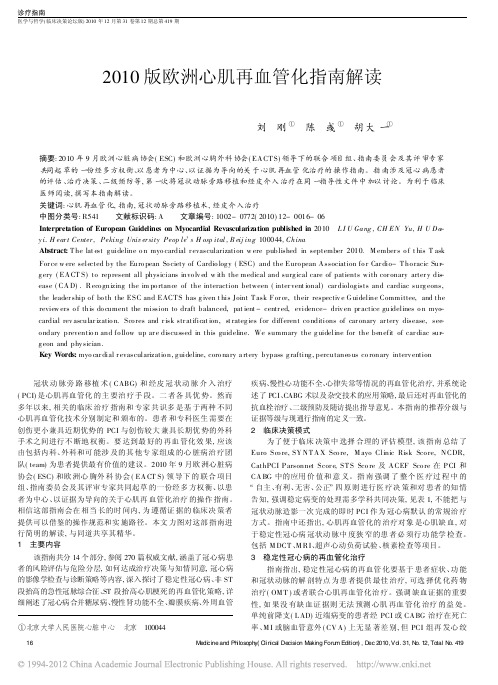
急性冠状动脉综合征
2010 版欧洲心肌再血管化指南解读 )) ) 刘 刚等 医学与哲学( 临床决策论坛版) 2010 年 12 月第 31 卷第 12 期 总第 419 期
2 年的随访中 P CI 等同于 CA BG , 但仍 需要长期随 访。对于 LM 合并有分叉口的病 变或 LM 合并 三支病 变者, 进 行 CA BG 有 更 好的生存优势, 见表 2。
指南指出, 稳定性冠心病的再血管 化要基于 患者症状、功 能 和冠状动脉的解 剖特点 为患 者提供 最佳 治疗, 可选 择优 化药 物 治疗( OM T ) 或者联合心肌再血管化治 疗。强调 缺血证据的重要 性, 如 果没 有缺 血证 据则 无法 预测 心肌 再血 管化 治疗 的益 处。 单纯前降支( L AD) 近端病变的患者经 PCI 或 CA BG 治疗在死亡 率、M I 或脑血管意外 ( CV A ) 上无显 著差 别, 但 PCI 组再 发心 绞
For ce w ere selected by the Euro pean So ciety of Cardio log y ( ESC) and the Euro pean A ssociation fo r Car dio- T ho racic Surg ery ( EA CT S) to represent all physicians invo lv ed w ith the medical and surg ical care of patients with cor onary arter y disease ( CA D) . R eco gnizing the im po rtance of the interaction between ( inter vent ional) car diolog ists and cardiac surg eons, the leader ship o f bo th the ESC and EACT S has g iven t his Joint T ask F or ce, their respectiv e G uideline Committee, and the review ers o f this do cument the mission to draft balanced, pat ient - centr ed, evidence- driv en pr actice guidelines o n myo-
- 1、下载文档前请自行甄别文档内容的完整性,平台不提供额外的编辑、内容补充、找答案等附加服务。
- 2、"仅部分预览"的文档,不可在线预览部分如存在完整性等问题,可反馈申请退款(可完整预览的文档不适用该条件!)。
- 3、如文档侵犯您的权益,请联系客服反馈,我们会尽快为您处理(人工客服工作时间:9:00-18:30)。
Thirteenth EditionApril 2009I NSTITUTE FOR C LINICAL S YSTEMS I MPROVEMENTThe information contained in this ICSI Health Care Guideline is intended primarily for health profes-sionals and the following expert audiences:• physicians, nurses, and other health care professional and provider organizations;• health plans, health systems, health care organizations, hospitals and integrated health care delivery systems;• health care teaching institutions;• health care information technology departments;• medical specialty and professional societies; • researchers;• federal, state and local government health care policy makers and specialists; and •employee benefit managers.This ICSI Health Care Guideline should not be construed as medical advice or medical opinion related to any specific facts or circumstances. If you are not one of the expert audiences listed above you are urged to consult a health care professional regarding your own situation and any specific medical questions you may have. In addition, you should seek assistance from a health care professional in interpreting this ICSI Health Care Guideline and applying it in your individual case.This ICSI Health Care Guideline is designed to assist clinicians by providing an analytical framework for the evaluation and treatment of patients, and is not intended either to replace a clinician's judgment or to establish a protocol for all patients with a particular condition. An ICSI Health Care Guideline rarely will establish the only approach to a problem.Copies of this ICSI Health Care Guideline may be distributed by any organization to the organization's employees but, except as provided below, may not be distributed outside of the organization without the prior written consent of the Institute for Clinical Systems Improvement, Inc. If the organization is a legally constituted medical group, the ICSI Health Care Guideline may be used by the medical group in any of the following ways:• copies may be provided to anyone involved in the medical group's process for developing and implementing clinical guidelines;•the ICSI Health Care Guideline may be adopted or adapted for use within the medical group only, provided that ICSI receives appropriate attribution on all written or electronic documents; and•copies may be provided to patients and the clinicians who manage their care, if the ICSI Health Care Guideline is incorporated into the medical group's clinical guideline program.All other copyright rights in this ICSI Health Care Guideline are reserved by the Institute for Clinical Systems Improvement. The Institute for Clinical Systems Improvement assumes no liability for any adaptations or revisions or modifications made to this ICSI Health Care Guideline.I NSTITUTE FOR C LINICALMain AlgorithmS YSTEMS I MPROVEMENTPharmacologic AlgorithmAlgorithms and Annotations .......................................................................................1-26Algorithm (Main) (1)Algorithm (Pharmacologic)................................................................................................2ForewordScope and Target Population .........................................................................................4Clinical Highlights and Recommendations ..................................................................4Priority Aims ..............................................................................................................4-5Key Implementation Recommendations .......................................................................5Related ICSI Scientific Documents ...........................................................................5-6Disclosure of Potential Conflict of Interest ...................................................................6Introduction to ICSI Document Development ..............................................................6Description of Evidence Grading ..................................................................................7Annotations ...................................................................................................................8-20Annotation (Main) ...................................................................................................8-14Annotation (Pharmacologic) ..................................................................................14-20Appendices ..................................................................................................................21-26Appendix A – Comorbid Conditions............................................................................21Appendix B – Medication Tables.................................................................................22Appendix C – Grading of Angina Pectoris ..................................................................23Appendix D – Omega-3 Fatty Acids ......................................................................24-26Supporting Evidence ....................................................................................................27-33Brief Description of Evidence Grading ............................................................................28References ...................................................................................................................29-33Support for Implementation .....................................................................................34-41Priority Aims and Suggested Measures .......................................................................35-36Measurement Specifications ..................................................................................37-38Key Implementation Recommendations ..........................................................................39Knowledge Resources ......................................................................................................39Resources Available .....................................................................................................40-41Table of ContentsWork Group LeaderGreg Lehman, MD Internal Medicine, Park Nicollet Clinic Work Group MembersCardiologyJoe H. Nguyen, MD CentraCareFamily Medicine Spencer Bershow, MD Fairview Health Services General InternistPhil Kofron, MD, MPH Park Nicollet Clinic Health Education Susan M. Hanson, RD Park Nicollet InstituteNursingShauna Schad, RN, CNS Mayo ClinicPharmacyPeter Marshall, PharmD HealthPartners Medical GroupFacilitatorsPenny Fredrickson ICSIMyounghee Hanson ICSIForewordScope and Target PopulationAdults who have a diagnosis of stable coronary artery disease. The criteria, as noted on the Main algorithm,includes patient presenting with:• previously diagnosed coronary artery disease without angina, or symptom complex that has remained stable for at least 60 days;• no change in frequency, duration, precipitating causes or ease of relief of angina for at least 60 days;and• no evidence of recent myocardial damage.Clinical Highlights and Recommendations• Prescribe aspirin in patients with stable coronary artery disease if there are no medical contraindications.(Annotations #2, 21a; Aim #2)• Evaluate and treat the modifiable risk factors, which include smoking, sedentary activity level, stress, hyperlipidemia, obesity, hypertension and diabetes. (Annotation #5; Aim #3)• Patients with chronic stable coronary artery disease should be on statin therapy regardless of their lipid levels unless contraindicated. (Annotation #21a; Aim #3)• Perform prognostic testing in patients whose risk determination remains unclear. This may precede or follow an initial course of pharmacologic therapy. (Annotation #7; Aim #7)• Refer the patient for cardiovascular consultation when clinical assessment indicates the patient is at high risk for adverse events, the non-invasive imaging study or electrocardiography indicates the patient isat high risk for an adverse event, or medical treatment is ineffective. (Annotations #15, 16; Aim #4)• For relief of angina, prescribe beta-blockers as first-line medication. If beta-blockers are contraindicated, nitrates are the preferred alternative. Calcium channel blockers may be an alternative medication if thepatient is unable to take beta-blockers or nitrates. (Annotations #21a, 21e; Aim #1) Priority Aims1. Increase the percentage of appropriate patients with an appropriate diagnosis of stable coronary arterydisease (SCAD), who are prescribed aspirin and antianginal medications. (Annotation #21a)2. Improve education/understanding around the management of stable coronary artery disease.3. Increase the percentage of patients with stable coronary artery disease who receive an intervention formodifiable risk factors.4. Improve the assessment of patients with a diagnosis of stable coronary artery disease who present withangina symptoms.5. Increase the use of angiotensin-converting enzyme (ACE) inhibitors or angiotensin II receptor blockers(ARBS) in patients with coronary artery disease, including those patients with a diagnosis of diabetes,chronic kidney disease, and hypertension.6. Increase the percentage of patients with a diagnosis of stable coronary artery disease who receive educa-tion around nutritional supplement therapy.7. Increase prognostic testing for patients whose risk determination remains unclear.Key Implementation RecommendationsThe following system changes were identified by the guideline work group as key strategies for health care systems to incorporate in support of the implementation of this guideline.1. Develop systems for providing patient education around:• Proper use of nitroglycerin• Consistent use of aspirin (unless contraindicated) or consistent use of clopidogrel as directed• When to call 911Education should also provide for patient to "teach back" in order to demonstrate their understanding of what they should do in an acute cardiac event.2. Develop/provide patients education materials around use of aspirin (unless contraindicated), interven-tions around modifiable risk factors.3. Provide patient education around the use and benefits of angiotensin-converting enzmes (ACE inhibi-tors) and/or angiotensin II receptor blockers (ARBs).Related ICSI Scientific DocumentsGuidelines• Diagnosis and Treatment of Chest Pain and Acute Coronary Syndrome (ACS)• Heart Failure in Adults• Hypertension Diagnosis and Treatment• Lipid Management in Adults• Major Depression in Adults in Primary Care• Diagnosis and Management of Type 2 Diabetes Mellitus• Preventive Services for Adults• Prevention and Management of Obesity in Adults and Mature Adolescents• Primary Prevention of Chronic Disease Risk FactorsTechnology Assessment Reports• Biochemical Markers of Cardiovascular Disease Risk (#66, 2003)• B-type Natriuretic Peptide (BNP) for the Diagnosis and Management of Congestive Heart Failure (#91, 2005)• Cardiac Rehabilitation (#12, 2002)• Drug-Eluting Stents for the Prevention of Restenosis in Native Coronary Arteries (#78, 2003)• Electron-Beam and Helical Computed Tomography for Coronary Artery Disease (#34, 2004)• Intracoronary Brachytherapy to Treat Restenosis after Stent Placement (In-stent Restenosis) (#34, 2002)• Omega-3 Fatty Acids for Coronary Artery Disease (#94, 2006)Disclosure of Potential Conflict of InterestICSI has adopted a policy of transparency, disclosing potential conflict and competing interests of all indi-viduals who participate in the development, revision and approval of ICSI documents (guidelines, order sets and protocols). This applies to all work groups (guidelines, order sets and protocols) and committees (Committee on Evidence-Based Practice, Cardiovascular Steering Committee, Women's Health Steering Committee, Preventive & Health Maintenance Steering Committee and Respiratory Steering Committee).Participants must disclose any potential conflict and competing interests they or their dependents (spouse, dependent children, or others claimed as dependents) may have with any organization with commercial, proprietary, or political interests relevant to the topics covered by ICSI documents. Such disclosures will be shared with all individuals who prepare, review and approve ICSI documents.No work group members have potential conflicts of interest to disclose.Introduction to ICSI Document DevelopmentThis document was developed and/or revised by a multidisciplinary work group utilizing a defined process for literature search and review, document development and revision, as well as obtaining input from and responding to ICSI members.For a description of ICSI's development and revision process, please see the Development and Revision Process for Guidelines, Order Sets and Protocols at .Evidence Grading SystemA. Primary Reports of New Data Collection:Class A: Randomized, controlled trialClass B: Cohort studyClass C: Non-randomized trial with concurrent or historical controlsCase-control studyStudy of sensitivity and specificity of a diagnostic testPopulation-based descriptive studyClass D: Cross-sectional studyCase seriesCase reportB. Reports that Synthesize or Reflect Upon Collections of Primary Reports:Class M: Meta-analysisSystematic reviewDecision analysisCost-effectiveness analysisClass R: Consensus statementConsensus reportNarrative reviewClass X: Medical opinionCitations are listed in the guideline utilizing the format of (Author, YYYY [report class]). A full explanation of ICSI's Evidence Grading System can be found at .Algorithm AnnotationsMain Algorithm Annotations1. Patient with Stable Coronary Artery DiseaseThis guideline applies to patients with coronary artery disease either with or without angina. Examplesinclude patients with prior myocardial infarctions, prior revascularization (i.e., percutaneous transluminalcoronary angioplasty [PTCA], coronary artery bypass graft [CABG]), angiographically proven coronaryatherosclerosis, or reliable non-invasive evidence of myocardial ischemia.A patient presenting with angina must meet all the following criteria (Hurst, 1990 [R]; Rutherford, 1992[R]; Shub, 1990 [R]):• Symptom complex has remained stable for at least 60 days• No significant change in frequency, duration, precipitating causes or ease of relief of angina for at least 60 days• No evidence of recent myocardial damageThe patient may already have undergone some diagnostic workup as a result of a prior presentation of chestpressure, heaviness and/or pain with or without radiation of the pain and/or shortness of breath. The clinicianshould have heightened awareness that many patients have atypical symptoms that reflect cardiac ischemia,especially women and the elderly. Initial care of such patients falls under the auspices of the ICSI Diagnosisand Treatment of Chest Pain and Acute Coronary Syndrome (ACS) guideline.2. Perform Appropriate History, Physical Examination, LaboratoryStudies and Patient EducationThorough history taking and physical examination, including medication and compliance reviews, areimportant to confirm diagnosis, to assist in risk stratification, and to develop a treatment plan (Rutherford,1992 [R]; Shub, 1990 [R]). Important points to elicit on history taking are:• recognition that women may have atypical symptoms of cardiac ischemia. These may include fatigue, shortness of breath (SOB) without chest pain, nausea and vomiting, back pain, jaw pain, dizzinessand weakness (Bell, 2000 [R]; Harvard Medical School, 2005 [R]; Kordella, 2005 [R]);• history of previous heart disease;• possible non-atheromatous causes of angina pectoris (e.g., aortic stenosis);• comorbid conditions affecting progression of coronary artery disease;• symptoms of systemic atherosclerosis (e.g., claudication, transischemic attack [TIAs] and bruits);and• severity and pattern of symptoms of angina pectoris.The physical examination should include a thorough cardiovascular examination, as well as evaluation forevidence of hyperlipidemia, hypertension, peripheral vascular disease, heart failure, anemia, thyroid disease,and renal disease.Initial laboratory studies should include an electrocardiogram and a fasting lipid profile (total cholesterol,HDL-cholesterol, calculated LDL-cholesterol and triglycerides). Further tests, based on history and physicalexamination findings, may include chest x-ray, measurement of hemoglobin, and tests for diabetes, thyroid function, and renal function.An important aspect to treatment of stable coronary artery disease is education to help the patient understand the disease processes, prognosis, treatment options, and signs of worsening cardiac ischemia so that prompt medical assistance is sought when necessary and appropriate. Education may be accomplished in a number of ways among the various medical groups. It may be ongoing, occur in a formal class, and/or be done at the provider visit. Instruction on the proper use of aspirin and sublingual nitroglycerin, as needed, should also be reviewed at this time.3. Non-Atherogenic Causes (e.g., Aortic Stenosis)?Aortic stenosis is an important non-atherogenic cause of angina. This and any other non-atherogenic causes are considered to be outside the scope of this clinical guideline (Shub, 1990 [R]).5. Address Modifiable Risk Factors and Comorbid ConditionsComorbid conditions that could affect myocardial ischemia may include hypertension, anemia, thyroid disease, hypoxemia and others.Modifiable risk factors for coronary heart disease need to be evaluated and may include smoking, inadequate physical activity, stress, hyperlipidemia, obesity, hypertension and diabetes mellitus. Intervention involving any risk factor pertinent to the patient is encouraged and may include education, goal setting, and follow-up as necessary (Rutherford, 1992 [R]; Shub, 1990 [R]).Please see Appendix A, "Comorbid Conditions," for treatment recommendations in the presence of comorbid conditions.Emerging Risk FactorsAn association between homocysteine levels and cardiovascular disease has been demonstrated. The NORVIT trial and HOPE 2 trial found that folate and vitamins B6 and B12 did not reduce the risk of recur-rent cardiovascular events in patients with vascular disease. These supplements cannot be recommended as routine treatment in patients with stable coronary artery disease (Bønaa, 2006 [A]; HOPE 2 Investigators, 2006 [A]).In select patients, clinicians may want to consider obtaining a lipoprotein (a) and highly sensitive C-reactive protein (hsCRP) (Ridker, 2005 [A]). Highly sensitive C-reactive protein and related markers of inflamma-tion may provide useful prognostic information and help guide further therapy for patients with coronary artery disease.InfluenzaPatients with cardiovascular disease should have an influenza vaccination as recommended by the American College of Cardiology/American Heart Association (ACC/AHA) Chronic Stable Coronary Artery Disease guideline (Smith, 2006 [R]).SmokingCigarette smoking may cause an acute cardiac ischemic event and may interfere with the efficacy of medi-cations to relieve angina.Please refer to the ICSI Preventive Services for Adults guideline for recommendations regarding smoking cessation.Sedentary Activity LevelAn important aspect of the provider's role is to counsel patients regarding appropriate work, leisure activities, eating habits and vacation plans. Patients should be encouraged to exercise regularly to obtain cardiovas-cular benefit and to enhance their quality of life. The American College of Cardiology (ACC) endorses a minimum schedule of 30-60 minutes of aerobic activity (walking, jogging, etc.) three to four times per week, supplemented by an increase in daily lifestyle activities (walking breaks at work, gardening, etc.) Medically supervised programs are recommended for moderate- to high-risk patients. Exercise can be an important adjunct to modification of risk factors such as hypertension, hyperlipidemia and obesity. In addition, it can enhance patients' perception of their quality of life. Strenuous activities should be modified if they produce severe or prolonged angina; caution is needed to avoid consistent reproduction of ischemic symptoms or situations that may precipitate ischemic complications. Education is critical in achieving these goals. A study (Hambrecht, 2005 [A]) showed less progression of coronary artery disease and significantly fewer ischemic events in patients who regularly exercised.StressPsychophysiologic stress is a notable feature of the relationship between myocardial ischemia and the patient's daily environment. Depressive symptoms are common in stable coronary artery disease patients, with prevalence estimates ranging from 15% to 30% (Kop, 2001 [R]). The American Heart Association recommends that depression be routinely screened for and appropriately treated in patients with coronary heart disease (Lichtman, 2008 [R]).HyperlipidemiaA fasting lipid profile should be evaluated for appropriate patients with stable coronary artery disease. Secondary prevention is important in these patients, who should be treated aggressively for hyperlipidemia. Many patients will require both pharmacologic and non-pharmacologic interventions to reach target goals. Target goals for hyperlipidemic patients with coronary artery disease include:LDL – less than 100 mg/dLHDL – 40 mg/dL or greaterTriglycerides – less than 150 mg/dLPlease refer to the ICSI Lipid Management in Adults guideline for recommendations on lowering lipid levels.ObesityThe American Heart Association considers obesity to be a major risk factor for coronary artery disease. Obesity is defined as a body mass index greater than 30. The loss of 5%-10% of an individual's weight can have health benefits such as decreasing blood pressure, cholesterol, decreasing the severity of obstructive sleep apnea, and improving glucose tolerance (Eckel, 1998 [X]).HypertensionGeneral health measures include the treatment of hypertension, which is not only a risk factor for develop-ment and progression of atherosclerosis, but also causes cardiac hypertrophy, augments myocardial oxygen requirements, and thereby intensifies myocardial ischemia in patients with obstructive coronary disease. Please refer to the ICSI Hypertension Diagnosis and Treatment guideline for recommendations regarding blood pressure management. The recommended target blood pressure is 130/80 mmHg or less.DiabetesDiabetes is associated with a marked increase in coronary artery disease. Patients with diabetes without known coronary artery disease have as high risk of a myocardial infarction as patients without diabetes with coronary artery disease. Therefore, patients with diabetes should have aggressive lipid and blood pressure management (similar to patients with coronary artery disease), and should be treated per the recommenda-tions of the ICSI Diagnosis and Management of Type 2 Diabetes Mellitus in Adults guideline, ICSI Lipid Management in Adults guideline and ICSI Hypertension Diagnosis and Treatment guidelines.Please refer to the ICSI Management of Type 2 Diabetes Mellitus guideline for recommendations regarding management of diabetes.Every attempt should be made to achieve meticulous glucose control in patients with diabetes, because there is a clear relationship between lower hemoglobin Alc's and lower risk of myocardial infarction (Haffner, 1998 [B]). In the UKPDS (United Kingdom Prospective Diabetes Study Group, 1998 [A]), obese patients with type 2 diabetes who were treated with metformin showed a statistically significant reduction in rates of myocardial infarction, suggesting metformin as a possible therapy of choice for these patients. A meta-analysis (Selvin, 2004 [M]) showed a 20% increase in cardiovascular events and mortality for every 1%c over 5%.increase in HbA1The Action to Control Cardiovascular Risk in Diabetes (ACCORD) trial showed an increase rate of mortality in the intensive treatment arm compared to the standard arm (hazard ratio of 1.22), and there was a similar increase in cardiovascular deaths (ACCORD, 2008 [A]). Many of these patients were treated with insulin and multiple oral agents, with a target of A1c < 6. There were more hypoglycemic reactions in the inten-sively treated group, and more weight gain compared to the standard treatment group. Compared to other trials of intensive control, patients in the ACCORD trial may have had diabetes for a longer period of time and started with a higher A1c before entering the intensive treatment arm. Implications for SCAD patients can be summarized in a joint paper published by the American Diabetes Association, the American College of Cardiology, and the American Heart Association (Skyler, 2009 [R]). In general older, more frail SCAD patients with more comorbid disease (like chronic kidney disease) may be at greater risk for hypoglycemia and other complications of intensive diabetes therapy; perhaps patients such as these should be allowed higher A1c goals, such as maintaining A1c < 8.0. Other SCAD patients with a more recent diagnosis of diabetes, and those with less risk for hypoglycemia and other complications of intensive treatment will still warrant aggressive therapy to a target of < 7.0. For all patients, lifestyle modification, including exercise, smoking cessation, maintaining ideal body weight, and proven risk factor reduction (Boden, 2007 [A]) will continue to be the focus of primary and secondary cardiovascular disease prevention. The A1c goal ought to be individualized based on each patient's particular cardiovascular risk factors.Hormone Therapy (HT)The HERS II trial showed no cardioprotective benefit from hormone therapy, and in fact showed an increase in risk of other complications (breast cancer, venous thromboembolism, etc.) (Hulley, 1998 [A]). Risk-benefit analyses unequivocally support NOT starting hormone therapy for primary prevention. Should a patient already on hormone therapy present with acute coronary syndrome or be at risk for venous thromboembolism(e.g., prolonged immobilization), hormone therapy should be discontinued immediately. Clinical judgementis required in making the decision whether to continue hormone therapy in other circumstances.6. Assessment Yields High Risk of Adverse Event?Some patients are considered to be at high risk for infarction or death on the basis of history, physical exami-nation and initial laboratory findings. Patients presenting with accelerating symptoms of angina (NYHA (New York Heart Association) Class III or IV, see Appendix C, "Grading of Angina Pectoris"), symptoms ofperipheral vascular disease, or symptoms of left ventricular dysfunction should be referred to a cardiologist unless precluded by other medical conditions.7. Need for Prognostic Testing?Prognostic testing is appropriate for patients in whom risk determination remains unclear after initial evalu-ations have been completed, or in whom cardiac catheterization is deemed inappropriate by the cardiologist.Prognostic testing may precede or follow an initial course of pharmacological therapy (Frye 1989 [R];Shub, 1990 [R]).8. Patient/Electrocardiogram Allows Exercise Electrocardiography?Sensitivity of exercise electrocardiography (Masters 2-Step Exercise Test, Graded Exercise Test, Bicycle Test, Ergometry) may be reduced for patients unable to reach the level of exercise required for near maximal effort, such as:• patients taking beta-blockers;• patients in whom fatigue, dyspnea or claudication symptoms develop; and• patients with vascular, orthopedic or neurological conditions who cannot perform leg exercises.Reduced specificity may be seen in patients with abnormalities on baseline electrocardiography, such as those taking digitalis medications, and in patients with left ventricular hypertrophy or left bundle branch block (Rutherford, 1992 [R]).9. Perform Exercise ElectrocardiographyMost patients with normal resting electrocardiographys who can exercise and are not taking digoxin can undergo standard treadmill exercise testing.10. Perform Non-Invasive Imaging StudyA non-invasive imaging study such as myocardial perfusion scintigraphy or stress echocardiography shouldbest meet the patient's needs while providing the most clinical usefulness and cost effectiveness within the provider's institution. An imaging study should be selected through discussion with the cardiologist or imaging expert (Frye, 1989 [R]).11. Results Yield High Risk of Adverse Event?Exercise electrocardiography and prognostic imaging studies may yield results that indicate high, interme-diate or indeterminate or low risk of adverse clinical events. High-risk patients should have a cardiology consultation unless they are not considered to be potential candidates for revascularization. Patients who are at intermediate or indeterminate risk may benefit from cardiology consultation and/or further non-invasive imaging if an exercise electrocardiogram has been performed. Low-risk patients can generally be managed medically, with a good prognosis. Low-risk patients may benefit from angiography if the diagnosis remains unclear; however, angiography is unlikely to alter outcome in these patients (Rutherford, 1992 [R]).13. Is Medical Treatment Effective?Effectiveness of pharmacologic treatment is measured by whether the anginal pain is controlled within the definition of stable coronary artery disease as stated in Annotation #1, "Patient with Stable Coronary Artery Disease."。
